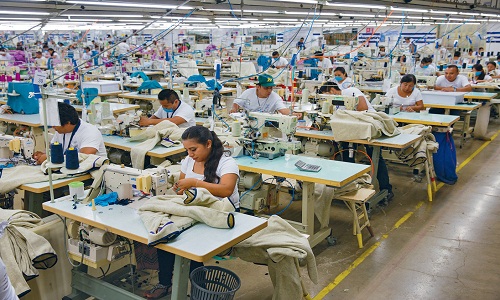"A growing phenomenon-- RPTN -- refers to geographically proximate countries forming a regional supply chain. Deepening of this RPTN increases the concentration of world textile and apparel exports. In general, three primary textile and apparel regional supply chains operate in the world today. Asian supply chain. Here, economically advanced Asian countries such asJapan, South Korea, China and Indiasupply textile raw material to the less economically developed countries such as Bangladesh, Cambodia, and Vietnam."
 A growing phenomenon-- RPTN -- refers to geographically proximate countries forming a regional supply chain. Deepening of this RPTN increases the concentration of world textile and apparel exports. In general, three primary textile and apparel regional supply chains operate in the world today:
A growing phenomenon-- RPTN -- refers to geographically proximate countries forming a regional supply chain. Deepening of this RPTN increases the concentration of world textile and apparel exports. In general, three primary textile and apparel regional supply chains operate in the world today:
Asian supply chain: Here, economically advanced Asian countries such asJapan, South Korea, China and Indiasupply textile raw material to the less economically developed countries such as Bangladesh, Cambodia, and Vietnam. Based on relatively lower wages, the less developed countries typically undertake the most labor-intensive processes of apparel manufacturing and then export finished apparel to major consumption markets around the world.
European supply chain: Developed countries in Southern and Western Europe such as Italy, France, and Germany, serve as the primary textile suppliers. Regarding apparel manufacturing in EU, products for the mass markets is typicallyproduced by developing countries in Southern and Eastern Europe such as Poland and Romania, whereas high-end luxury products are mostly produced by Southern and Western European countries such as Italy and France. Furthermore, a high portion of finished apparel is shipped to developed EU members such as UK, Germany, France, and Italy for consumption.
US supply chain: In this regional supply chain, the United States serves as the leading textile supplier, whereas developing countries in North, Central andSouth America (such as Mexico and countries in the Caribbean region) assemble imported textiles from the United States or elsewhere into apparel. The majority of clothing produced in the area is eventually exported to the UnitedStates or Canada for consumption.
andSouth America (such as Mexico and countries in the Caribbean region) assemble imported textiles from the United States or elsewhere into apparel. The majority of clothing produced in the area is eventually exported to the UnitedStates or Canada for consumption.
Associated with these regional production and trade networks, three trade flows are important to watch:
Asian countries emerge major sourcing hub for Asia: In 2017, close to 80 per cent of Asian countries’ textile imports came from other Asian countries, up from around 70 per cent in the 2000s.
EU intra-region trade in textile, apparel stable:In 2017, 55 percent of EU countries’ textile imports and 47 percent of EU countries’ apparel imports came from within the EU region. Over the same period, 68 percent of EU countries’ textile exports and 75 percent of their apparel exports also went to other EU countries.
Western hemisphere supply chain becomes unbalanced
In 2017, as much as 80 percent of textiles and 89 percent of apparel exports from the Western hemisphere went to the same region. However, the operation of Western hemisphere supply chain is facing competition from Asian suppliers. For example, in 2017, only 24.8 percent of North, South and Central American countries’ textile imports and 15.7 percent of their apparel imports came from within the region, a record low in the past 10 years.
Implementation of several new free trade agreements, such as CPTPP, RCEP, EU-Vietnam FTA, and the potential US-EU and US-Japan FTAs is on the cards. How they affect regional pattern of world textile and apparel trade remains to be seen.












